Us Gulf Of Mexico
-
- 2016 and Two FPSOs in US GoM: The 20 Year Saga Maritime Logistics Professional, Q2 2016 #54
Peter Lovie’s Chronology of the FPSO’s difficult struggle to viability in the U.S. Gulf of Mexico is a fascinating journey through time and the oil industry itself.
2016 saw the arrival of the second FPSO in the US Gulf of Mexico. Despite the long prominence of the US Gulf of Mexico in pioneering in the offshore world, FPSOs have been curiously slow in arriving despite being the most used floating production system in the rest of the world. Tracing what went on from securing regulatory approval in principle to be able to use FPSOs in GoM, through the unexpected events in the industry, changes in design criteria and the decision making that lead to where we are today with one FPSO in operation and a second about to start, both employing unique Jones Act shuttle tankers, is not an easy task. The story begins in 1996.How did it all start?The first FPSO anywhere in the world is usually taken to be Shell’s Castellon FPSO offshore Spain that started operation in 1977. It was not until 1995-1996 that Texaco’s Fuji prospect drew attention to the possible use of an FPSO in GoM, this for an unusual requirement in 1,700 feet of water – deep water in these days – and at a relatively remote location from pipelines.In late 2001 the MMS Record of Decision stated that: “In 1996, OCS operators, as well as builders and operators of FPSO vessels, began having serious discussions with the MMS about the possibility of using FPSO systems in the Gulf of Mexico.” It was the operators in US Gulf of Mexico (GoM) that took the initiative to open these discussions with the MMS which revealed that MMS would require an Environmental Impact Statement (EIS) before they would consider any application to use an FPSO for any specific field development in GoM.An EIS had not been required for earlier facilities in deep water, and MMS did not see why they should undertake that effort for the industry at their cost. Potential operators wanted to be able to have the FPSO in their “toolbox” for immediate action without that EIS delay. Discussion led to DeepStar, enlisting the support of 60+ stakeholder organizations, stepping forward to act on behalf of the industry to both fund and support the preparation of an EIS. It ultimately took more than $3 million from the operators to get it done: $1 million of funding to MMS plus in excess of $2 million in expenditures incurred by operators.The 793-page EIS was published by MMS in January 2001, followed by the US government’s formal Record of Decision on 13 December 2001. MMS then announced it was ready to accept applications for the use of FPSOs in GOM in its press release on January 2, 2002.Success in achieving acceptance of the EIS led to the question of what it would take to move forward with FPSOs in GoM. The common best guess that industry bandied around in 2002 was that there might be four to six FPSOs in GoM in the next ten years. Despite the willingness of the MMS to accept FPSO applications, no projects came forward until years later. Years later in sitting down to write this saga in 2016 and comparing notes with the father of the EIS (Allen Verret), Peter Lovie concluded that under the current post Macondo regulatory systems and climate, doing the EIS for FPSOs in 2016 would be virtually impossible.In 2000, a supermajor conducted an assessment on the use of FSOs to store crude oil production from expected nearby spars. A vigorous and protracted debate went on for months, weighing engineering and economic factors. It led eventually to abandoning the FSO idea.Use of shuttle tankers follows naturally from the use of vessels requiring offloading, i.e. FSOs and FPSOs. With the EIS in place at the end of 2001 the stage was set at the start of 2002 for developing shuttle tanker business to support expected FPSO installations. These were the circumstances that led to two competing companies to propose shuttle tanker services for the US GoM market. Both faced the same ground rules – shuttle tankers in GoM had to be Jones Act compliant: US built, US crewed and 75+% US owned.Tanker construction for the US was far more difficult than anywhere else in the world – fewer shipyards, slower delivery and about 2-1/2 times as costly than the industry was used to seeing in the Far East. The two shuttle tanker contenders chose different solutions to the same problem.The first off the mark was Conoco’s subsidiary Seahorse Shuttling & Technology LLC that chose to create a new DP2 design tailored to GoM conditions, to be built in a shipyard in Alabama with Korean input. Seahorse Shuttling was closely followed in the marketplace by American Shuttle Tankers LLC (AST), a 50:50 venture of Navion of Stavanger and Skaugen PetroTrans. The combination thus brought together local GoM experience with the best available in shuttle tanker expertise from the more harsh environment of the North Sea. The AST shuttle tankers would also be DP2, this time either an existing tanker design adapted to be a newbuild in a US yard, or would be a DP2 conversion of an existing product tanker of Handymax size.By 2004, however, the need for FPSOs and hence shuttle tankers realistically became “Slim Pickens.” Inquiries for shuttle tankers were few despite multiple deepwater developments out on the horizon. And, by 2005, there then was no shuttle tanker contractor in the business of proposing services for GoM.The Hurricanes of 2005Just as the shuttle tanker contractors had left the scene, along came Katrina and Rita to further complicate things. They were two of the worst hurricanes offshore in living memory: both in the same year, weeks apart. MMS counted 113 production platforms destroyed and 52 heavily damaged in these two hurricanes. A record number of Mobile Offshore Drilling Units (MODUs) set completely adrift. It dawned on operators that here was a collision hazard that had not been anticipated in their planning and design. No one could ever knowingly take that kind of risk – a small probability but a risk with horrendously large consequences. The regulators did not come up with this requirement: once again it was the operators that took the lead. Despite all the bad press attributed to big oil, this was the oil companies acting responsibly and doing so without any government decree.Disconnection of an FPSO in GoM was a new phenomenon, not associated with traditional hurricane effects or standard regulatory requirements. Careful forecasting and disciplined integration with disconnection preparation became necessary. There was a minor side benefit in that it made it possible to more readily modify topsides if ever needed and do it dockside nearby rather than offshore with a permanently moored FPSO.Macondo: it all hits the fanThe final competition for the first FPSO in US GoM ended up being a close race, with BW Offshore finally drawing ahead by a nose to win the contract to design, build and lease the first FPSO in the Gulf of Mexico, for a five year term with three one year options. Simultaneous with the FPSO bid competition the shuttle tanker competition opened up. In other parts of the world this bid process might not be so difficult but here in the US there was the Jones Act to contend with. Petrobras America did a remarkable job in sifting through the various offerings. Conversion of newbuild tankers ultimately won the day.All looked fine for once. The Petrobras America team had successfully managed their way through the procurement and construction of the first FPSO in GoM and its pioneering progress through MMS and USCG regulatory approvals, even though it was for a world record breaking water depth. BW Offshore had completed the BW Pioneer FPSO in Singapore and sailed it to the Gulf of Mexico, arriving in late February of 2010.Within days of the first FPSO arriving in GoM, the Macondo disaster happened. Everything shut down. Looking back, it is difficult to imagine more things going wrong on the arrival of the first FPSO in GoM, and yet the FPSO team at Petrobras America managed its way through it all.Then came an upheaval in the regulatory regime: MMS was dismantled by the Obama Administration in reaction to Macondo, replaced with a new regulatory structure. Past processes that were underway with Cascade/Chinook became subject to reexamination and change. With Washington paranoia in the air, the regulatory climate became more difficult for the Petrobras America team to deal with as operator. Along the way, they were managing the shift from project to steady operation. Their team deserves recognition for their achievement in overcoming all obstacles.2012: Recovery and first oilAt long last, production operations did start in the US GoM. 25 February 2012 was a day of celebration: first oil. Since then more than 81 offloadings have occurred. On 24 April 2012 Shell filed its Deep Water Operational Plan (DWOP) with BSEE for the Stones development about 200 miles from New Orleans, for an FPSO as host in Walker Ridge 551. Then in 2013 Shell announced its firm commitment for the design, construction and operation of an FPSO under a lease contract with SBM for their Stones development in a record 9,500 ft. water depth. This became the second FPSO in the US GoM.2013 also saw a Shell commitment with OSG for a time charter for the third shuttle tanker for offloading operations in US GoM: the OSG Tampa, a Handymax size of products tanker delivered from Aker Philadelphia in 2011, converted in 2014 in Poland to shuttle tanker configuration.The outlook for more FPSOs in GoMWhy have FPSOs taken so long in GoM? There are some fundamental differences in the GoM from the rest of the world. One of these is geography: GoM has a flat alluvial plain going out a hundred plus miles, making it simple and cost efficient to lay pipelines out to where production platforms are located, unlike (say) the Norwegian Trench that helped prompt development of shuttle tankers in the Norwegian North Sea.US oil and gas domestic production has been in great demand for US domestic consumption. Until the very end of 2015 it was even against US law to export oil from GoM to other countries. Consequently there was no incentive to think of storing and sending the oil outside the country. Only recently in a very few particularly remote and deep waters in GoM has necessity overridden other production and delivery solutions to make FPSOs the ultimate choice.In December 2015 legislation was signed into law to allow export of crude oil from the US. One of the questions that used to be asked was “Can we export the production from an FPSO to somewhere that is outside the US? The answer hitherto had to be NO. Now it would seem there is no reason why an FPSO in US GoM could not – in theory – offload to a foreign flag export tanker and send the oil outside the country, conceivably with good financial advantage. Longer cycle times could be a drawback and with shuttle tankers already on charter, there may be little incentive to try foreign tonnage. So it sounds academic at this point in market history but does offer a new option to Petrobras or Shell for their GoM developments.Shuttle tankers remain a difficult solution for GoM, living with the Jones Act, despite advances elsewhere in the world that do not have these constraints and additionally benefit from a larger scale of operations to justify optimizing what might be possible with tanker export. In 2016, the prospects look doubly remote when considering the need for securing an outlook of several years at reasonably stable and favorable oil prices to justify a commitment for a third FPSO in GoM that may be measured in the billions of dollars.The saga of FPSOs in GoM has taken a lot of energy and enthusiasm over the years but realism does seem to have set in – there may be little chance of another BW Pioneer or Turritella sailing into the GoM in the next decade.(As published in the Q2 2016 edition of Maritime Professional) -
- Offshore: OSV Market Report Maritime Reporter, Nov 2019 #28
the price of oil. Seacor Marine’s John Gellert, in reviewing its Q2 results, said: “Activity levels in the U.S. Gulf of Mexico remain tepid as customer demand is highly sensitive to oil and gas prices.” In spite of these efforts, and in the face of demand slowdowns, stockpiles of oil have
-
- Hornbeck Offshore Services: Exerting Energy in All the Right Places Maritime Logistics Professional, Q2 2013 #24
are expected to mobilize to Hornbeck Offshore’s core markets. Matching supply with the anticipated demand is at the core of CEO Todd Hornbeck’s short term business plan. That’s it. There are, of course, other key components of that vision, but it is the simplicity of the base premise that makes industry stakeholders
-
- MN 100: Harvey Gulf International Marine News, Aug 2014 #32
Coast and U.S. Gulf of Mexico. Eventually, Harvey Gulf transitioned from a full-service towing operator to one specializing in offshore towing, with a focus on towing large jack-up and semi-submersible rigs in the deepwater and ultra-deepwater of the Gulf of Mexico. The Case: Recently, Harvey Gulf Internation
-
- Rig Demand in the Doldrums Maritime Reporter, Apr 2004 #24
Worldwide demand for mobile offshore drilling units remains essentially flat, according to Houston-based offshore industry analyst ODSPetrodata, although offshore drilling activity is expected to increase modestly in certain areas as the year progresses. U.S. Gulf of Mexico rig demand has fallen
-
- Local Yards Start To Feel The Impact Maritime Reporter, Jul 2001 #26
the renewed vigor with which companies will explore and develop deepwater fields for the production of natural resources. Though the resumption of business at "full throttle" has taken perhaps a bit longer than many observers would have initially predicted, particularly given the continued high
-
- Cautious Consolidation for OSV Companies Brings Market Change Marine News, Nov 2018 #30
the boats? In the U.S. Gulf of Mexico, that remains to be seen.Offshore services, exploration and production are on a roll. In early October, yet another business combination of big drillers was announced. In a sign of optimism, Ensco announced its plan for an all-stock acquisition of Rowan Offshore, worth
-
- Subsea Technology and the New Routes to Residency Marine Technology, Jul 2020 #38
7’s tetherless autonomous intervention vehicle (AIV) has demonstrated its autonomous behaviours for inspection work offshore Norway and in the US Gulf of Mexico. In August, Norway’s IKM Subsea reached a 100-day continuous subsea operations milestone with its tethered Merlin UCV R-ROV at the Snorre
-
- [Op/Ed] The Gulf of Mexico: An Energy Platform for America Marine News, Sep 2020 #22
Even as business, schools and scenes from everyday life seem frozen as society adjusts to the coronavirus, the U.S. marches closer toward the November presidential election. In early August, Vice President Joe Biden announced Senator Kamala Harris as his running mate. As the Biden-Harris ticket works out
-
- Greasing the Skids Maritime Reporter, Jun 2001 #56
, OPEC solidarity and a U.S. administration doling out incentives for exploration and production all add up to good news for those companies conducting business in or profiting from the offshore market. There is little doubt that the international offshore market, led by the Gulf of Mexico, is poised
-
- Oil Instability, consolidation Muddy Offshore E&P Picture Maritime Reporter, Nov 2000 #27
The cyclical nature of the oil business has blossomed into full bloom during the latter part of 2000, as a host of political power plays have sent oil prices on a virtual rollercoaster, albeit mostly up, helping to send it soaring as high as $37/barrel at the time of this writing. The business of accuratel
-
- Seacor Continues Rational Fleet Expansion Maritime Reporter, Apr 2001 #44
has emerged as one of the world's premier operators of a fleet of vessels that provide marine services to the oil and gas exploration and pro- duction industry, and oil spill response services in the U.S. Gulf of Mexico, North Sea, offshore West Africa, the Far East and Latin America. For the fiscal year
-
 )
March 2024 - Marine Technology Reporter page: 48
)
March 2024 - Marine Technology Reporter page: 48. . .Birns, Inc. . . . . . . . . . . . . . . . . . . . . . . . . . . .www.birns.com . . . . . . . . . . . . . . . . . . . . . . . . . . . . . . .Please visit us online 19 . . . . .Blueprint Subsea . . . . . . . . . . . . . . . . . . . .www.blueprintsubsea.com . . . . . . . . . . . . . . . . . . . . . .+44 (0)
-
 )
March 2024 - Marine Technology Reporter page: 44
)
March 2024 - Marine Technology Reporter page: 44. Scandinavia (BUVI) to join its international sales team. Image courtesy Unique Group Sealing the deal(s) @ Oi ‘24 mating the object identi? cation process using the SAS Target in a single work? ow. The sensor’s 360-degree scanner and Assistant. The application runs in the background, leaving us- high collection
-
 )
March 2024 - Marine Technology Reporter page: 33
)
March 2024 - Marine Technology Reporter page: 33regulated industry in the world.” How- ever, commercial success depends on many factors, not least a predictable OPEX. Over the past four years, SMD has worked with Oil States Industries to calculate cost per tonne ? gures for prospective customers. Patania II uses jet water pumps to Oil States’
-
 )
March 2024 - Marine Technology Reporter page: 32
)
March 2024 - Marine Technology Reporter page: 32- the Pentagon is expected to deliver an ac- light plastic tracks and buoyant syntactic foam. The collec- tion plan on nodules by March 2024. tion vehicle uses sonar to identify the position of the nodules UK-based Soil Machine Dynamics (SMD) designed, devel- and has attained collection ef? ciency rates
-
 )
March 2024 - Marine Technology Reporter page: 27
)
March 2024 - Marine Technology Reporter page: 27SEA-KIT USV Maxlimer returning from HT-HH caldera in Tonga. © SEA-KIT International data and further assess ecosystem recov- ery. What is known, noted Caplan-Auer- bach, is that the impact of submarine vol- canoes on humans is rare. “The HT-HH eruption was a tragedy, but it was very unusual. It let us
-
 )
March 2024 - Marine Technology Reporter page: 25
)
March 2024 - Marine Technology Reporter page: 25mobilized away still had abundant life, including the Tonga Eruption Seabed Mapping Even before the recent HT-HH erup- corals, sponges, star? sh and mussels. Project (TESMaP) to understand the ex- tion, subsea technology helped scien- This indicated the resilience of certain tent of impact and inform
-
 )
March 2024 - Marine Technology Reporter page: 15
)
March 2024 - Marine Technology Reporter page: 15sensor options for longer mission periods. About the Author For glider users working in ? sheries and conservation, Shea Quinn is the Product Line Manager the Sentinel can run several high-energy passive and active of the Slocum Glider at Teledyne Webb acoustic sensors, on-board processing, and imaging
-
 )
March 2024 - Marine Technology Reporter page: 9
)
March 2024 - Marine Technology Reporter page: 9from marinas along the western coast. The exact number of lizing laser detection systems can detect mines just below the mines, as well as their locations, remains largely a mystery, surface, even those hiding in murky water. The Airborne Laser although reports suggest that over three hundred have been
-
 )
March 2024 - Marine Technology Reporter page: 6
)
March 2024 - Marine Technology Reporter page: 6(NOAA), and hai Ocean University in 2018. He proposed making thick wall Oceanographer of the Navy. He has a bachelor’s degree from glass spheres to Nautilus Marine Service/Vitrovex (Germany) the U.S. Naval Academy, and master and doctoral degrees from that opened the hadal depths to routine exploration
-
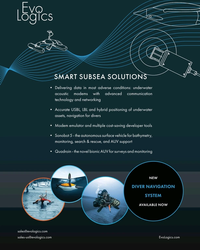 )
March 2024 - Marine Technology Reporter page: 2nd Cover
)
March 2024 - Marine Technology Reporter page: 2nd CoverSMART SUBSEA SOLUTIONS • Delivering data in most adverse conditions: underwater acoustic modems with advanced communication technology and networking • Accurate USBL, LBL and hybrid positioning of underwater assets, navigation for divers • Modem emulator and multiple cost-saving developer tools • Sonobot
-
 )
April 2024 - Maritime Reporter and Engineering News page: 48
)
April 2024 - Maritime Reporter and Engineering News page: 48& CHAINS MILITARY SONAR SYSTEMS tel:+44 (0) 1752 723330, [email protected] , www.siliconsensing.com Anchor Marine & Supply, INC., 6545 Lindbergh Houston, Massa Products Corporation, 280 Lincoln Street, SONAR TRANSDUCERS Texas 77087 , tel:(713) 644-1183, fax:(713) 644-1185, Hingham, MA 02043-1796
-
 )
April 2024 - Maritime Reporter and Engineering News page: 41
)
April 2024 - Maritime Reporter and Engineering News page: 41Nautel provides innovative, industry-leading solutions speci? cally designed for use in harsh maritime environments: • GMDSS/NAVTEX/NAVDAT coastal surveillance and transmission systems • Offshore NDB non-directional radio beacon systems for oil platform, support vessel & wind farm applications
-
 )
April 2024 - Maritime Reporter and Engineering News page: 38
)
April 2024 - Maritime Reporter and Engineering News page: 38operational autonomy of the BP re? nery, two miles from the Port of Castellón in Spain. up to eight hours, providing an ef? cient and non-polluting solu- Using its electric line handling tug Castalia, Consulmar towed tion for mooring operations. In addition to mooring, the mul- the steel mooring lines from
-
 )
April 2024 - Maritime Reporter and Engineering News page: 35
)
April 2024 - Maritime Reporter and Engineering News page: 35. FORCE Technology’s upcoming DEN-Mark2 math- lock around 50-80 times a day. It has ematical model release for its augmented reality SimFlex4 tug W changed us. Half the people surveyed and ship simulator will offer unprecedented model accuracy in a 2022 King’s College London study said that they feel like
-
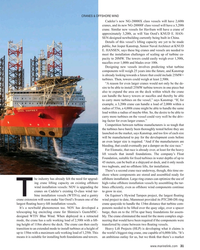 )
April 2024 - Maritime Reporter and Engineering News page: 31
)
April 2024 - Maritime Reporter and Engineering News page: 31and thereby be able to carry more turbines on the vessel,” says Kanstrup. “If, for example, a 3,200t crane can handle a load of 2,000t within a radius of 55m, a 4,000t crane might be able to handle the same load within a radius of maybe 68m. So, the desire to be able to carry more turbines on the
-
 )
April 2024 - Maritime Reporter and Engineering News page: 29
)
April 2024 - Maritime Reporter and Engineering News page: 29. Navy photo by Bill Mesta/released U.S. Navy photo by Ryan Carter Rear Adm. Philip Sobeck, Commander, United States Navy’s Military Sealift Command, visits USNS Patuxent (T-AO 201) for a tour of the ship at Naval Station Norfolk, Va., November 20, 2023. ENDLESS SUPPLY OF MARINE HARDWARE ! &"$)$?""?!!&"$l •
-
 )
April 2024 - Maritime Reporter and Engineering News page: 28
)
April 2024 - Maritime Reporter and Engineering News page: 28for the Mis- sile Defense Agency, and it travels with its support ship, the MV Hercules. For our Service Support ships, we have the two hospital ships, USNS Mer- cy and Comfort; two rescue and salvage ships; two submarine tenders; and the Sixth Fleet ? agship, USS Mount Whit- ney, that has a combined
-
 )
April 2024 - Maritime Reporter and Engineering News page: 27
)
April 2024 - Maritime Reporter and Engineering News page: 27RADM PHILIP SOBECK, MILITARY SEALIFT COMMAND With COVID, we had to make some hard choices for our Do your CIVMARs have upward mobility? mariners because we couldn’t rotate. Many of our mariners The Navy has Sailors who become “Mustangs,” and work found other employment, and were able to use their skills
-
 )
April 2024 - Maritime Reporter and Engineering News page: 26
)
April 2024 - Maritime Reporter and Engineering News page: 26replaced.” Rear Adm. Philip Sobeck, Commander, United States Navy’s Military Sealift Command Military Sealift Command’s expeditionary fast transport ship USNS Burlington (T-EPF 10) pulls into Joint Expeditionary Base Little Creek-Fort Story, Feb. 14. USNS Burlington is the U.S. Navy’s newest expeditionary
-
 )
April 2024 - Maritime Reporter and Engineering News page: 25
)
April 2024 - Maritime Reporter and Engineering News page: 25RADM PHILIP SOBECK, MILITARY SEALIFT COMMAND Photo by Brian Suriani USN Military Sealift Command From a global supply chain perspective, What makes MSC so vital to the we’ve learned a lot about dealing with Navy’s ? eet and our military disruptions. COVID delivered a big forces around the world? wake-up
-
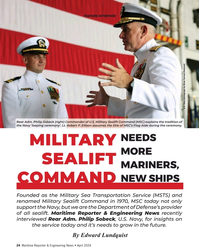 )
April 2024 - Maritime Reporter and Engineering News page: 24
)
April 2024 - Maritime Reporter and Engineering News page: 24FEATURE INTERVIEW U.S. Navy photograph by Brian Suriani/Released Rear Adm. Philip Sobeck (right) Commander of U.S. Military Sealift Command (MSC) explains the tradition of the Navy ‘looping ceremony’. Lt. Robert P. Ellison assumes the title of MSC’s Flag Aide during the ceremony. NEEDS MILITARY MORE
-
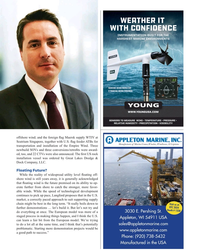 )
April 2024 - Maritime Reporter and Engineering News page: 23
)
April 2024 - Maritime Reporter and Engineering News page: 23and installation of the Empire Wind. Three newbuild SOVs and three conversions/retro? ts were award- ed, too, and 22 CTVs were also announced. The ? rst US rock installation vessel was ordered by Great Lakes Dredge & Dock Company, LLC. Floating Future? While the reality of widespread utility level ? oating
-
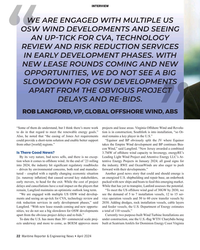 )
April 2024 - Maritime Reporter and Engineering News page: 22
)
April 2024 - Maritime Reporter and Engineering News page: 22INTERVIEW WE ARE ENGAGED WITH MULTIPLE US OSW WIND DEVELOPMENTS AND SEEING AN UP-TICK FOR CVA, TECHNOLOGY REVIEW AND RISK REDUCTION SERVICES IN EARLY DEVELOPMENT PHASES. WITH NEW LEASE ROUNDS COMING AND NEW OPPORTUNITIES, WE DO NOT SEE A BIG SLOWDOWN FOR OSW DEVELOPMENTS APART FROM THE OBVIOUS
-
 )
April 2024 - Maritime Reporter and Engineering News page: 21
)
April 2024 - Maritime Reporter and Engineering News page: 21ROB LANGFORD, VP, GLOBAL OFFSHORE WIND ob Langford has worked in the offshore industry ABS. “We are growing and evolving our services across all for more than three decades, ‘cutting his teeth’ offshore infrastructure along with our continued support to the in a UK design ? rm working in the North Sea
